Overview of the Global Anemia Problem, Including Iron Deficiency Anemia
The World Health Organization (WHO) defines anemia among women of childbearing age as the condition of having a hemoglobin concentration of < 12.0 g/dL at sea level; among pregnant women it is defined as < 11.0 g/dL. The hemoglobin concentration cutoff level that defines anemia varies by age, gender, physiological status, smoking status, and the altitude at which the assessed population lives.
The primary cause of anemia is iron deficiency, a condition caused by inadequate intake or low absorption of iron, the increased demands of repeated pregnancies—particularly if not well spaced (e.g., fewer than 36 months between pregnancies)—and loss of iron through menstruation. Other causes of anemia include vitamin deficiencies (such as a deficiency of folic acid or vitamin A), genetic disorders, malaria, parasitic infections, HIV, tuberculosis, common infections, and other inflammatory conditions. While iron deficiency anemia (IDA) accounts for about one-half of all anemia cases, it often coexists with these other causes.
Iron deficiency anemia is most common during pregnancy and in infancy, when physiological iron requirements are the highest and the amount of iron absorbed from the diet is not sufficient to meet many individuals’ requirements (Stoltzfus and Dreyfuss 1998). Anemia’s effects include increased risk of premature delivery, increased risk of maternal and child mortality, negative impacts on the cognitive and physical development of children, and reduced physical stamina and productivity of people of all ages (Horton and Ross 2003). Globally, IDA annually contributes to over 100,000 maternal deaths (22 percent of all maternal deaths) and over 600,000 perinatal deaths (Stoltzfus, Mullany, and Black 2004). Key anemia control interventions include promoting a diversified diet, iron-folic acid (IFA) supplementation during pregnancy, iron fortification of staple foods, prevention and treatment of malaria, use of insecticide-treated bed nets, helminth prevention and control, delayed cord clamping, and increased birth spacing.
Maternal Anemia in Kenya
The prevalence rate of anemia among pregnant women in Kenya is 55 percent, making it a severe public health problem as defined by the WHO standards1 (Mwaniki et al., 2002). Regarding anemia severity, the majority of cases among pregnant and non-pregnant women in the country are classified as mild or moderate.2 Only 2.1 and 4.4 percent of anemia cases among non-pregnant and pregnant women are diagnosed as severe.
Disaggregated by geographic regions, prevalence rates of anemia may be much higher. A study conducted in western Kenya among pregnant women who visited a large, urban hospital in the Kisumu district for their first ANC visit revealed that the prevalence of any and moderate anemia among these women was 69 and 12 percent, respectively (Ouma et al., 2007). In that study, malaria was found to be one of the most important determinants of anemia.
Falter Points in Women's Consumption of Iron-Folic Acid During Pregnancy
WHO recommends that all pregnant women receive a standard dose of 30–60 mg iron and 400 μg folic acid beginning as soon as possible during gestation (WHO 2012a). Ideally, women should receive iron-containing supplements no later than the first trimester of pregnancy, which means ideally taking 180 tablets before delivery. It is important to note, that many countries aim for women to receive 90 or more tablets during pregnancy.
Figure 1 on the following page shows a decision-tree analysis of how well the Kenyan antenatal care (ANC) system distributes IFA, and identifies four potential points at which the system might falter (highlighted in orange). The figure tracks the number and percentage of women who obtained ANC, those who subsequently received and consumed at least one IFA tablet, and those who consumed the ideal minimum number of tablets.3 All data are based on Kenya Demographic and Health Survey (KDHS) questions that were asked of women who were in a permanent union and had been pregnant in the five years prior to being interviewed4 (KDHS; KNBS and ICF Macro 2010).
Figure 1. Analysis of Falter Points Related to Distribution and Consumption of IFA through Kenya’s ANC Program in 2008/09, Women of Reproductive Age (15–49 Years) n = 8,444
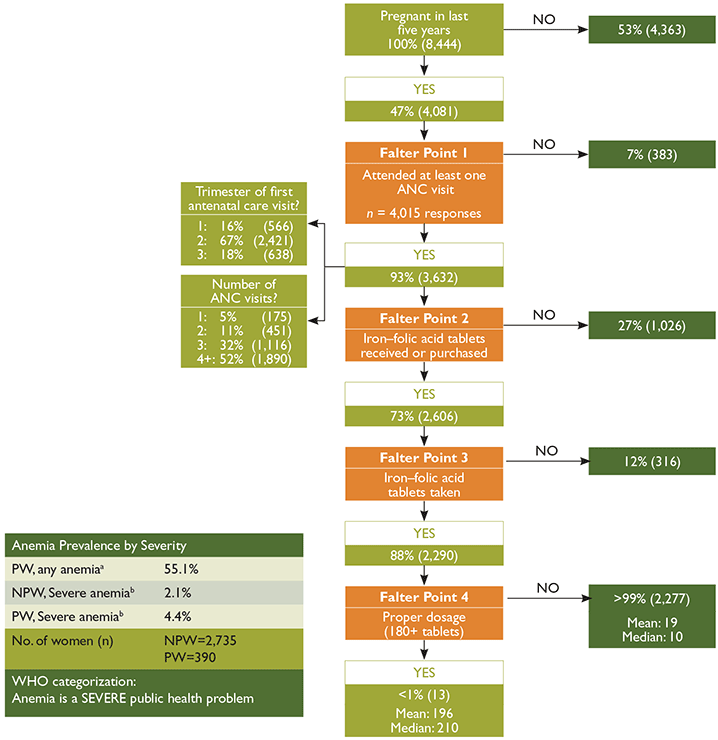
Main Conclusions: ANC has high coverage and provides an outstanding platform for IFA distribution. Among women who were pregnant in the last five years, had at least one ANC visit, and took at least one IFA tablet, less than one percent received and took the ideal minimum number of tablets. The most important shortcoming is Falter Point 4, but Falter Points 2 and 3 are significant as well. Both supply and demand considerations need to be investigated.
aNPW Hb<12, PW<11 bNPW Hb<8.0, PW Hb<7.0
Non-responses, no data were recorded to “No” for “At least one ANC visit?”, “IFA tablets received?” and “IFA tablets taken?” and to zero for “Number of tablets taken?”
Anemia prevalence data are provided as a reference point, signaling the general order of magnitude of the anemia public health problem. The ANC utilization data is based on self-reported data of women 15–49 years in permanent unions and pertains to their last pregnancy in the last five years prior to the DHS survey.
Source: Calculations are from the Kenya Demographic and Health Survey (2008). Anemia levels are from WHO VMNIS, Reference: 3442, 1999.
Many supply-side aspects—including both adequacy of IFA tablet supplies and technical knowledge and practices of ANC providers—need to be considered when assessing how well an ANC program delivers IFA. In addition, Falter Point 4 in Figure 1 clearly shows that the provision of IFA tablets to a pregnant woman is a necessary but not sufficient condition for the woman to consume the tablets, particularly at the ideal minimum. Thus, demand-side factors also play a critical role in determining the coverage and effectiveness of this program. These include whether or not women seek antenatal care and the timing and number of visits, as well as the extent to which women are aware of the significance of anemia and IFA, ask for IFA tablets, and comply with the IFA regimen.
Understanding the relative significance of each falter point enables them to be prioritized for more in-depth analysis, providing a first step in an evidence-based approach to systematically improving the program. The DHS does not collect information on the number of IFA tablets received by women. In the case of Falter Point 4, this lack of data creates ambiguities that make it impossible to fully understand whether shortcomings of the system relate primarily to supply- or to demand-side factors. Despite this limitation, the decision-tree analysis presented in Figure 1 still enables prioritizing the falter points for more in-depth analysis and action at the national, district, and health center levels.
Analysis of Falter Points
Falter Point 1:
Did not attend at least one ANC visit
Only seven percent of women did not obtain at least one ANC visit.
ANC’s high coverage makes it a strong vehicle for providing IFA.
Falter Point 2:
Did not receive or purchase at least one IFA tablet
Of the women with at least one ANC visit, 27 percent did not receive or purchase any IFA.
There are several system/supply-side performance shortcomings that need additional analysis, including: (1) Inadequate supply (e.g., stock outs); (2) provider knowledge; and (3) provider practices. These three factors are directly implicated in Falter Point 2, and as shown in Figure 1, represent the second most important falter point among pregnant women in Kenya.
Unfortunately, the KDHS does not report the source(s) of the IFA tablets women received or purchased. While less than one percent of Kenyan women who received or purchased IFA did not have any ANC visits (not shown), it is difficult to ascertain whether or not those who received ANC care obtained their IFA tablets from their ANC provider. It is likely, however, that women who attend ANC are more likely to be aware of, to value, and to be inclined to also take IFA, regardless of where they obtain them. Thus we would expect there to be a high correlation between the number of women who had at least one ANC visit and those who received or purchased IFA, which is consistent with the data. Regardless of source of supply, it is clear that women who have had one or more ANC visits and who did not receive any IFA, constitute a missed opportunity to reduce the risk of IDA among a high-risk population.
Falter Point 3:
Did not take at least one IFA tablet
Of the women who received IFA, 12 percent did not consume any tablets.
This demand-side constraint is relatively large by international standards, and may be due to women not understanding the significance of anemia and/ or the significance of IFA. This misunderstanding may reflect: (1) inadequate provider counseling and follow-up; (2) women’s beliefs about actual or possible side-effects; or (3) sociocultural factors.
Falter Point 4:
Did not consume 180 or more IFA tablets
Of the women who received and took IFA, more than 99 percent did not consume the ideal minimum of 180 IFA tablets.
Figure 1 sheds some light on two possible causes of Falter Point 4, although further research is needed to establish their relative importance. First, 85 percent of women who received ANC began their care after the first trimester, and were therefore unlikely to receive the recommended minimum IFA regimen due to a late initiation of ANC. Second, the 48 percent of women who had less than WHO’s recommended four ANC visits during their last pregnancy may have likewise started their ANC too late, or may not have had enough visits to receive and consume the 180 tablets. Both of these are likely contributing factors, and may be tied to both demand- and/or supply-side constraints.
Globally, research has found that other common causes of Falter Point 4 include: (1) providers do not have access to adequate supply; (2) women do not receive adequate tablets because they have little access to care, or start ANC late, or do not have enough ANC visits making it difficult to obtain 180 tablets (given IFA distribution protocols); (3) providers do not provide adequate counseling or follow-up; (4) women do not adhere to the regimen, which may be due to difficulty in remembering to take the tablets daily, not knowing all the tablets are necessary, fear of having a big baby, side effects, or tablet-related issues (taste, size, color, coating, packaging/storage problem). Further research is needed to determine the specific reasons for this falter point in Kenya.
Table 1. Changes in ANC and IFA Coverage among Kenyan Women Aged 15–49 Years with a Live Birth in the Past Five Years, 2003–2008/09
| Characteristic | 2003 | 2008/09 | Coverage Change | |||
|---|---|---|---|---|---|---|
| Had 1 + ANC Visits | Took 1 + IFA | Had 1 + ANC Visits | Took 1 + IFA | Had 1 + ANC Visits | Took 1 + IFA | |
| Province | ||||||
| Residence | ||||||
| Wealth Quintile | ||||||
| Nairobi | 96% | 36% | 97% | 64% | 1% | 28% |
| Central | 93% | 26% | 94% | 72% | 0% | 45% |
| Coast | 89% | 57% | 95% | 78% | 6% | 21% |
| Eastern | 92% | 27% | 94% | 71% | 2% | 44% |
| Nyanza | 90% | 53% | 95% | 77% | 4% | 24% |
| Rift Valley | 89% | 41% | 90% | 67% | 1% | 25% |
| Western | 94% | 51% | 94% | 64% | 1% | 13% |
| North Eastern | 32% | 20% | 70% | 28% | 38% | 8% |
| Urban | 94% | 39% | 97% | 74% | 3% | 35% |
| Rural | 89% | 41% | 92% | 68% | 3% | 27% |
| Lowest | 79% | 43% | 85% | 61% | 6% | 18% |
| Second | 90% | 41% | 95% | 71% | 5% | 30% |
| Middle | 93% | 43% | 94% | 70% | 1% | 27% |
| Fourth | 94% | 36% | 94% | 71% | 0% | 35% |
| Highest | 95% | 40% | 96% | 74% | 1% | 34% |
| National Average | 90% | 41% | 93% | 69% | 3% | 29% |
Analysis by Sociodemographic Variables and Trends over Time
Tables 1 and 2 provide a disaggregated look at ANC and IFA coverage and the changes in those indicators between 2003 and 2008/09. The 2008/09 national ANC coverage rate (the percentage of pregnant women with at least one ANC visit) of 93 percent was exceeded in six of Kenya’s eight provinces. The major exception to very high ANC coverage rates is North Eastern province, which reaches only 70 percent. A large proportion of the people of North Eastern are nomadic, making the provision of care challenging. As may be seen in Table 1, however, the 70 percent coverage rate marked a dramatic improvement from 2003, when North Eastern’s coverage rate was just 32 percent.
The 2008/09 national IFA coverage rate (the percentage of women, among all women who were pregnant in the past five years, who received and took at least one IFA tablet) increased from 41 percent to 69 percent in the period between KDHS surveys. Here too, North Eastern had the lowest IFA coverage by far among the eight provinces, in both 2003 and 2008/09. Looking at Table 2, one can see that there were large increases in IFA coverage in all provinces between 2003 and 2008/09. The increases ranged from seven percentage points in North Eastern to 45 percentage points in Central, which given their very different starting points, constitute increases of 35 percent and 173 percent, respectively. This is a remarkable achievement. There has not been similar progress, however, in the coverage of women receiving at least 90 IFA tablets.
Table 2. Changes in IFA Consumption in Kenya, 2003–2008/09
| Characteristic | 2003 | 2008/09 | Coverage Change | |||
|---|---|---|---|---|---|---|
| Took 1 + IFA | Took 90 + IFA | Took 1 + IFA | Took 90 + IFA | Took 1 + IFA | Took 90 + IFA | |
| Province | ||||||
| Residence | ||||||
| Wealth Quintile | ||||||
| Nairobi | 36% | 4% | 64% | 4% | 28% | 0% |
| Central | 26% | 1% | 71% | 1% | 45% | 0% |
| Coast | 57% | 4% | 77% | 3% | 20% | -1% |
| Eastern | 27% | 0% | 71% | 2% | 44% | 2% |
| Nyanza | 53% | 4% | 76% | 5% | 23% | 2% |
| Rift Valley | 42% | 3% | 66% | 2% | 25% | -1% |
| Western | 51% | 4% | 64% | 1% | 13% | -3% |
| North Eastern | 20% | 1% | 27% | 1% | 7% | -1% |
| Urban | 39% | 3% | 74% | 3% | 34% | 0% |
| Rural | 41% | 2% | 67% | 2% | 27% | 0% |
| Lowest | 43% | 3% | 61% | 2% | 18% | -1% |
| Second | 41% | 2% | 71% | 3% | 30% | 1% |
| Middle | 43% | 2% | 69% | 3% | 26% | 0% |
| Fourth | 36% | 1% | 70% | 2% | 35% | 0% |
| Highest | 40% | 4% | 73% | 4% | 34% | 0% |
| National Average | 41% | 3% | 69% | 3% | 28% | 0% |
In fact, the percentage of women taking 90 or more tablets actually fell in four out of eight provinces, and there was no change in the national coverage rate of three percent. There is substantial potential for improving the coverage of IFA in Kenya, and even greater potential for increasing the quantity of IFA tablets distributed to and consumed by pregnant women.
Analysis by Geographic Region
The map in Figure 2 shows how the percentage of women with at least one ANC visit who received at least one IFA tablet varies by province. The percentage varies substantially, from 34 percent in the North Eastern province to 77–80 percent in Nyanza and Coast.
Figure 2. Percentage of Women Who Had at Least One ANC Visit and Received at Least One IFA Tablet by Province, Kenya, 2008/09
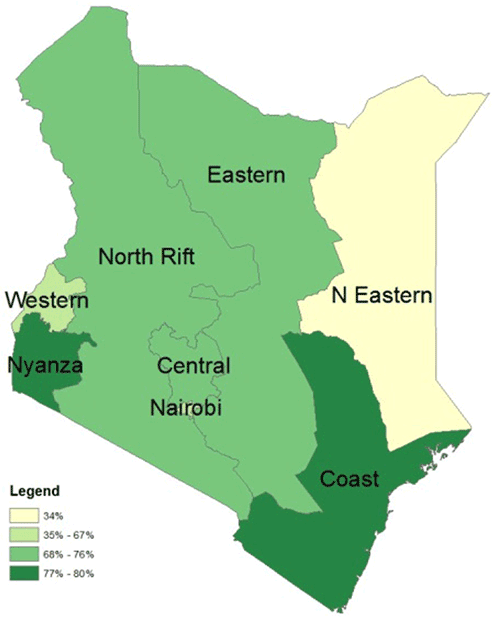
Analysis by Number of ANC Visits
Table 3 contains data from the 2003 and 2008/2009 KDHS, and reveals that over this period Kenya made progress in the health system coverage of pregnant women: (1) the percentage of pregnant women with at least one visit increased from 90 percent to 93 percent, with the greatest increase seen among women with two to three visits; and (2) the timing of the initiation of ANC improved, with the median month of first visit decreasing from 5.9 months to 5.7 months. Despite this progress, most women still make their first ANC visit during the second or third trimester, making it unlikely that their ANC coverage time would be sufficient for them to consume the ideal minimum IFA dose.
Table 3. Number and Timing of ANC Visits, Kenya, 2003 and 2008/09
| Indicator | 1998 | 2006 | Change in Coverage | Percentage Change |
|---|---|---|---|---|
| Number of ANC Visits | ||||
| Month of First Visit | ||||
| Media Month of First Visit | ||||
| 0 | 9.6% | 7.3% | -2.3% | -24.0% |
| 1 | 4.2% | 4.3% | 0.1% | 2.4% |
| 2-3 | 31.3% | 39.2% | 7.9% | 25.2% |
| 4+ | 52.3% | 47.1% | -5.2% | -9.9% |
| Don't Know/No Data | 2.6% | 2.0% | -0.6 | -23.1% |
| No ANC | 9.6% | 7.3% | -2.3% | -24.0% |
| < 4 | 11.1% | 14.6% | 3.5% | 31.5% |
| 4-5 | 36.7% | 37.7% | 1.0% | 2.7% |
| 6-7 | 37.1% | 36.8% | -0.3% | -0.8% |
| 8+ | 4.9% | 3.3% | -1.6% | -32.7% |
| Don't Know/No Data | 0.7% | 0.3% | -0.4% | -57.1% |
| 5.9 | 5.7 | |||
Figure 3 shows the relationship between the number of IFA tablets taken by women who had at least one ANC visit and the number of ANC visits they had during their last pregnancy. Among women who had at least one ANC visit, 93 percent took at most one-quarter (45) of the ideal minimum number of IFA tablets. The relationship between ANC visits and the number of IFA tablets received and taken is weak. Additional ANC visits did not always result in an increase in the number of IFA tablets consumed. Even among those women who received IFA tablets and had four or more visits, 92 percent took at most 45 tablets.
Figure 3. ANC Distribution of IFA Tablets: Number of Tablets Received and Taken According to Number of ANC Visits, Kenya, 2008/09
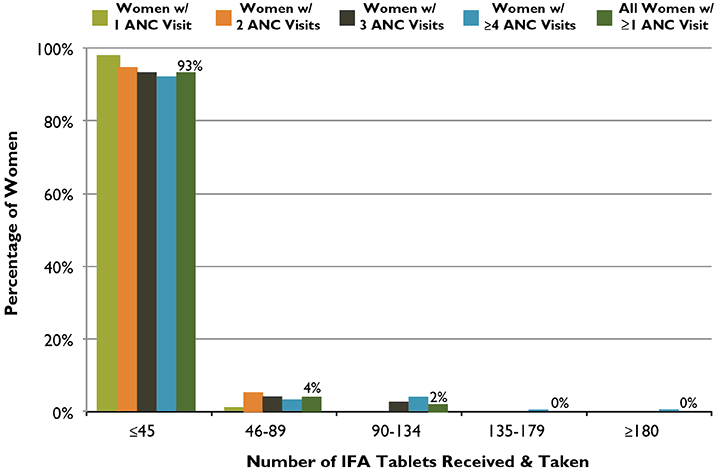
Overall Conclusions and Recommendations
Figure 4 presents the obstacles amongst all women, including those who did not receive ANC during their pregnancy, to taking the ideal minimum number of IFA tablets. In Kenya, Falter Points 2 and 4 are the greatest barriers. Improving the delivery of IFA supplementation in Kenya will require identifying and addressing program gaps in IFA supply management and health workers’ practices (to improve performance at Falter Points 2 and 4). Modifying some women’s long term adherence behaviors (addressing Falter Point 4), and addressing other points mentioned above, such as timing and number of ANC visits, may also lead to more women taking a minimum of 180 tablets.
Figure 4. Relative Importance of Each Falter Point in Kenya: Why Women Who Were Pregnant in the Last Five Years Failed to Take the Ideal Minimum of 180 IFA Tablets
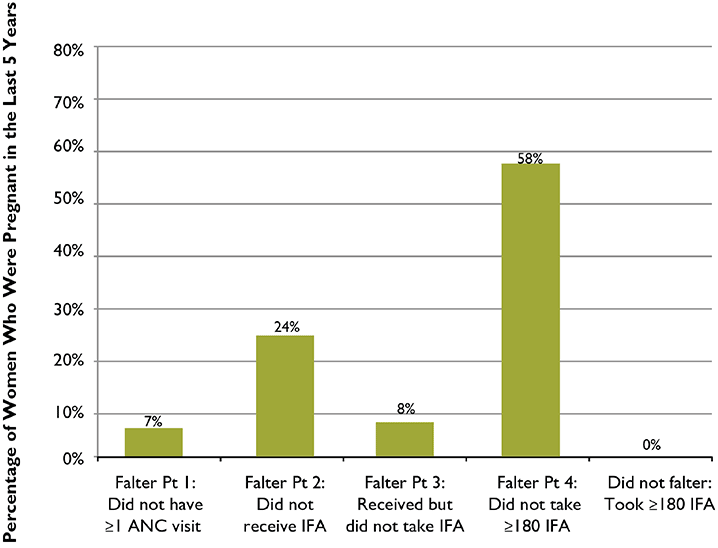
For most of the decade after adopting the Millennium Development Goal (MDG) challenge to reduce the maternal mortality ratio (MMR) by three-quarters (MDG 5A), Kenya’s MMR actually deteriorated (Figure 5). Since 2000, however, it has been able to turn around this situation and has now made notable progress in steadily reducing its MMR (WHO 2012b). Still, it will be a challenge for Kenya to achieve its MDG 5A target of decreasing its MMR to 157 or less maternal deaths per 100,000 live births.
Between 2003 and 2008/09, both ANC and IFA coverage improved notably in most parts of Kenya and in most sub-populations. Nevertheless, this rapid assessment suggests that there is substantial room for improvement in both the supply- and demand-sides of the program, which would help it to accelerate the rate at which it is decreasing MMR. Kenya could benefit from formative research to better understand the specific causes of the shortcomings in the falter points listed above, which will be essential to developing a strategy to address them as expeditiously as possible. Improving the distribution of IFA through the ANC program is an important strategy to prevent and control anemia in Kenya, and to improve the nutrition and health status, as well as the mental and physical capacity of women of reproductive age.
Figure 5. Kenya’s Progress in Reducing Maternal Mortality and Its MDG5 Target
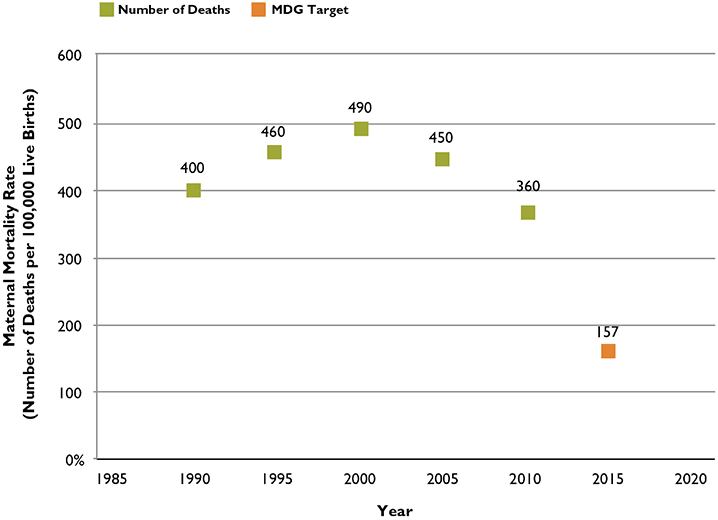
Footnotes
1 The WHO categorizes the severity of anemia as a public health problem according to its prevalence: <5%, no public health problem; 5–19.9%, mild; 20–39.9% moderate; ≥40%, severe.
2 The WHO hemoglobin levels used to diagnose the severity of anemia in pregnant and non-pregnant women in hemoglobin grams/deciliter are: Mild 10.0-10.9 (P) 10.0-11.9 (NP); Moderate 7.0-9.9 (P) 7.0-10.9 (NP); Severe <7.0 (P) <8.0 (NP); Any <11.0 (P) <12.0 (NP).
3 The KDHS asked about IFA tablets or capsules; this brief refers to all types as “tablets”.
4 The KDHS provides a population-based, nationally representative sample of all women in Kenya.
References
Division of Malaria Control [Ministry of Public Health and Sanitation], Kenya National Bureau of Statistics (KNBS), and ICF Macro. 2011. 2010 Kenya Malaria Indicator Survey. Nairobi, Kenya: Ministry of Public Health and Sanitation, Kenya National Bureau of Statistics, and ICF Macro.
Galloway, Rae. 2003. Anemia Prevention and Control: What Works. Washington, DC: USAID.
Horton, Sue and Jay Ross. 2003. “The Economics of Iron Deficiency.” Food Policy 28(1):51-75.
Kenya National Bureau of Statistics (KNBS) and ICF Macro. 2004. Kenya Demographic and Health Survey 2004. Calverton, Maryland: Kenya National Bureau of Statistics and ICF Macro.
Kenya National Bureau of Statistics (KNBS) and ICF Macro. 2010. Kenya Demographic and Health Survey 2008-09. Calverton, Maryland: Kenya National Bureau of Statistics and ICF Macro.
Mwaniki, D. L., Omwega, A. M., Muniu, E. M., Mutunga, J. N., Akelola, R., Shako, B. R., Gotink, M. H., and A. M. Pertet. 2002. Anaemia and status of iron, vitamin A and zinc in Kenya. The 1999 National Survey. Nairobi: Ministry of Health.
National Policy Guideline on Combined Iron and Folic Acid (IFA) Supplementation for Pregnant Mothers in Kenya. Ministry of Public Health and Sanitation, January 2013.
Ouma, Peter, van Eijk, Anna M., Hamel, Mary J., Parise, Monica, Ayisi, John G., Otieno, Kephas, Kager, Piet A., and Laurence Slutsker. 2007. “Malaria and anaemia among pregnant women at first antenatal clinic visit in Kisumu, western Kenya.” Tropical Medicine and International Health 12(12): 1515-1523.
Stoltzfus, Rebecca J., and Michele L. Dreyfuss. 1998. Guidelines for the use of Iron Supplements to Prevent and Treat Iron Deficiency Anemia. Washington DC: ILSI Press.
Stoltzfus, Rebecca J., Luke Mullany, and Robert E. Black. 2004. “Iron Deficiency Anemia.” In Comparative Quantification of Health Risks: Global and Regional Burden of Disease Attributable to Selected Major Risk Factors, edited by Majid Ezzati, Alan D. Lopez, Anthony Rodgers, and Christopher J. L. Murray, 163-209. Geneva, Switzerland: World Health Organization.
World Health Organization (WHO). 2012a. Guideline: Daily Iron and Folic Acid Supplementation in Pregnant Women. Geneva, World Health Organization.
WHO. 2012b. Indicator and Measurement Registry version 1.6.0. Maternity mortality rate. [August 28, 2012].